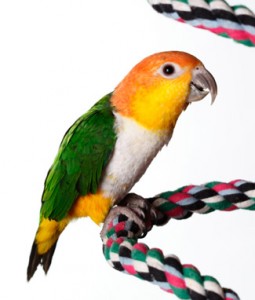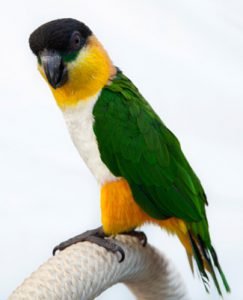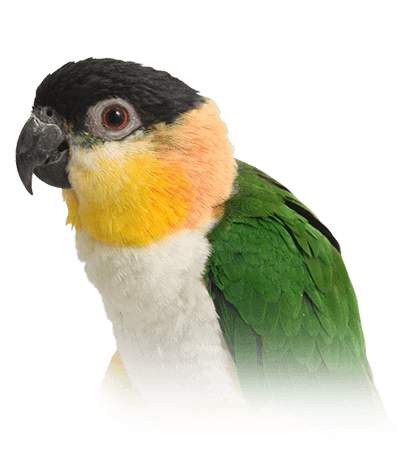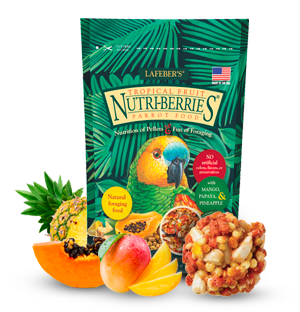
Caiques have been called clowns of the bird world for good reason — the clown is a truly appropriate metaphor for this high-energy, medium-sized mischief maker. You haven’t seen playful until you’ve seen a caique in action.
- Color
Green, Yellow - Size
medium - Lifespan
Up to 30 years - Sounds
Vocal communicator - Interaction
Highly social

- Caiques like to play on the backs and an excited caique might hop
- Two species of caiques are commonly kept as pets: the black-headed caique (Pionites melanocephala) and the white-bellied caique (Pionites leucogaster)
- Diet & Nutrition: Parrot food
Want to stay up-to-date on Caiques?

What Is A Caique?
 Well known as the clown of companion birds, caiques are loved by bird fanciers for their outgoing nature and ability to make people laugh with their playful antics. The proper way to pronounce caique is “kai-eke” — don’t ask for a “cake” at the bird shop, or they might point you to the nearest bakery!
Well known as the clown of companion birds, caiques are loved by bird fanciers for their outgoing nature and ability to make people laugh with their playful antics. The proper way to pronounce caique is “kai-eke” — don’t ask for a “cake” at the bird shop, or they might point you to the nearest bakery!
If the African grey parrot is the intellectual of the bird community, and the macaw is the show-off, then the caique is the clown. Caiques have been called clowns more often than Barnum and Bailey have had shows in three rings, and for good reason-the clown is a truly appropriate metaphor for this medium-sized mischief maker.
Two species of caiques are commonly kept as pets: the black-headed caique (Pionites melanocephala) and the white-bellied caique (Pionites leucogaster). The yellow-thighed caique, a subspecies of the white-bellied, is also kept as a pet, though it is less common in the pet trade. The black-headed and the white-bellied caique have a similar appearance, with a few obvious distinctions. They both are about 9 to 10 inches long, and their color composition is relatively simple, with “sections” of the bird in green, orange, yellow, and white.
 The black-headed caique has, obviously, a black head and black beak, while the white-bellied has, you guessed it, a white belly (so does the black-headed, incidentally), horn-colored beak, and a bright orange and yellow head. The caique is a stocky bird, surprisingly heavy for its size, as most new owners will point out.
The black-headed caique has, obviously, a black head and black beak, while the white-bellied has, you guessed it, a white belly (so does the black-headed, incidentally), horn-colored beak, and a bright orange and yellow head. The caique is a stocky bird, surprisingly heavy for its size, as most new owners will point out.
Native Region / Natural Habitat
Caiques are native to South America.
Care & Feeding
Though the caique is a medium-sized bird, it needs a large environment. This energetic bird will suffer greatly from being confined to a small cage. Think about building a small aviary if you can, or at least provide your caique with the largest housing you can afford. Make sure that the bar-spacing is appropriate for a bird of its size and that there’s a grating on the bottom of the cage. This playful bird will discover the weaknesses in its cage in no time, so be sure that the cage is of quality construction, such as those made from stainless steel.
As with most parrots, caiques thrive on a pelleted-base diet that is supplemented with fresh fruit and vegetables. Nutri-Berries are an especially good food for caiques because they offer fun foraging and balanced nutrition.
Personality & Behavior
Aside from the caique’s striking appearance, its personality is the primary reason for its rise in popularity. Caique owners rave about this plucky, active, little comedian. Most bird owners know that they will have to accept the good, the bad, and the “ugly” part of bird ownership when they take on a feathered companion. The caique makes a wonderful pet, but it’s not perfect. They can be stubborn and beaky, and very willful. But they are so cute, it’s difficult to fault them. Keep a very watchful eye on your caique if you have other birds in the house-they are known for bird-on-bird aggression, and care should be taken that the caique does not injure another pet bird.
Toys are a staple of the caique’s energy-diet. Caiques are always “on the go” and love to play with toys, especially toys that they can demolish. Be sure to have a steady supply of new toys on hand to replace the old ones when they become ragged or are disassembled. You’ll have to experiment with several types of toys to find your caique’s favorites. Fortunately, there are many types of toys on the market to choose from, but make sure that they are safe before you give them to your caique.
Speech & Sound
Caiques can’t compete in a noise contest with a cockatoo, but they are not quiet, by any means. Their noise level is moderate, and will only bother your more “sensitive” neighbors. They are not known for their talking ability, but can learn to whistle and cluck very well. A talented caique will talk, but its mimicking does not rival that of the better talking species.
Health & Common Conditions
Because of the caique’s curious nature and tendency to play hard, a pet caique can might find itself in a dangerous situation. Make sure your caique has plenty of bird-safe toys to play with and that you keep a close eye on your pet whenever it is out of the cage. Caiques might be more susceptible to polyomavirus, which results in gastroenteritis and also affect the bird’s heart, liver and kidney.
Caique Populations In The Wild
The caique is becoming ever more popular as a companion bird, but you may have to do your research to acquire one — most pet shops will not carry this species. You will more likely have to contact a breeder or find an all-bird shop to purchase your caique.
Have Questions? Contact Us!
Lafeber is a family company dedicated to its customers and the health of all animals. We really value feedback, and if you have any questions or concerns, please do not hesitate to contact us.
Please email: customerservice@lafeber.com Or call us and a real person will pick up the phone: (815) 888-4040






